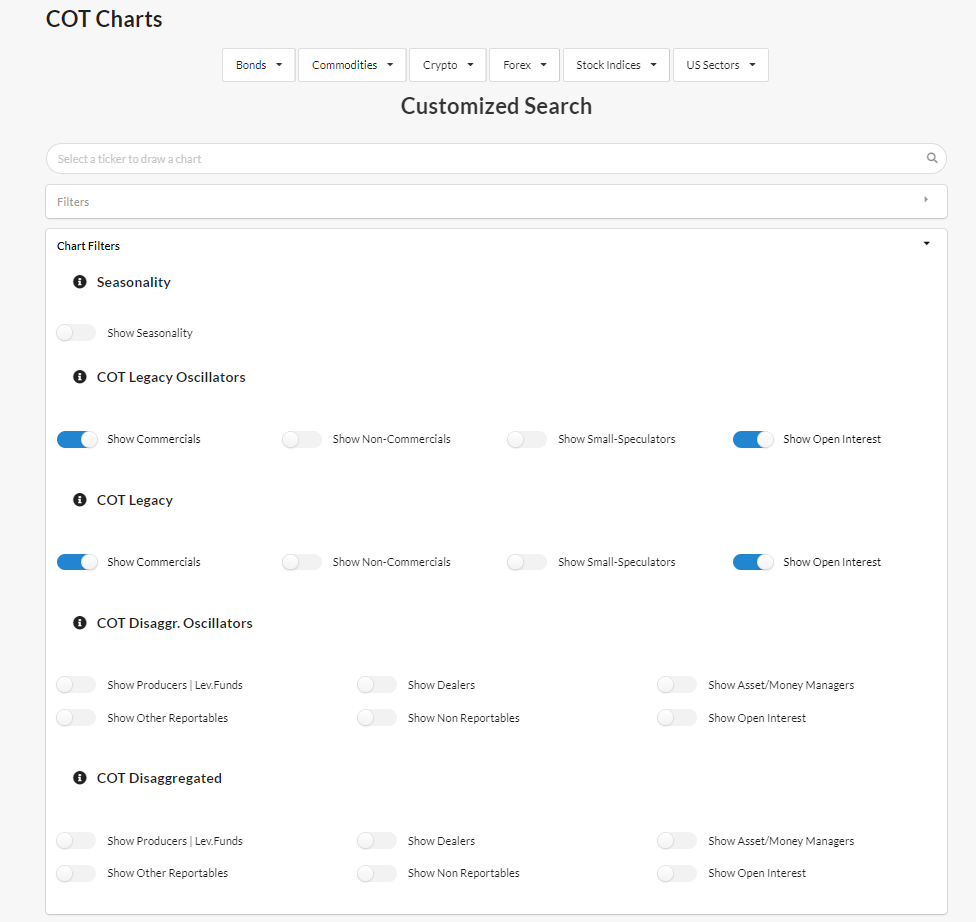COT Chart Filters
COT filters allow to customize the visualization of COT-data: to select the groups of traders to display, and choose whether to combine detrended seasonality.
The COT Chart is composed by 1 to 6 sub-charts:
- The first is always present, and is the Price with Moving-Average
- Then, for each one of the 5 areas, including 'Seasonality', if you select at least one line, it will be plotted one additional sub-chart.
Below, a detailed explanation of each area and COT group of Traders. You can find the same information in the COT charts page, in the (i) info boxes and by going mouse-over some texts.

- Seasonality
- if you select 'Show Seasonality', you will see a Chart with the Detrended Seasonality of the instrument
- Seasonality is the average behavior of the price in a calendar-year
- it can be a powerful indicator, giving more strength to a signal, if in harmony with Trend and COT
- COT Legacy Oscillators
- A technical-analysis oscillator built over the COT Legacy Data, and shows how a Legacy group is positioned with respect to the N previous weeks.
- It gives area of over-bought and over-sold
- 'Commercials' (hedgers) Tops occurs with Price Bottoms
- 'Non Commercials' & 'Small Speculators' (trend-followers) Tops occurs with Price Bottoms
- 'Open Interest' (OI): sometimes OI Tops coincides with Price Tops, and 'OI' Bottoms with Price Bottoms.
- COT Legacy
- Data is taken from the 'COT Legacy Report', the one with the deeper-history and most-famous one.
- This report categorize Traders in 3 groups:
- Commercials
- They use the market to manage or hedge their position in order to ensure the profit in their core business, not to speculate. They use to be the Smart Money, the best informed operators.
- Since they are hedgers, a potential buy zone in price occurs when their net position is highly positive, especially relative to the previous N weeks (and the opposite for a short-zone).
- For example in Commodities they are Producers, or in Financials they are Big-Banks hedging positions.
- Non-Commercials
- They are Large speculators (Hedge-Funds, Pension-Funds).
- They are trend followers, so their maximum net long position will occurs at market peaks (and the opposite for price bottoms).
- Almost always their net-position is the opposite of the 'Commercials' ones.
- Small-Speculators
- They are market operators, mainly trend-followers, that move a significantly smaller amount of money than the previous 2 categories. Their official name is 'Non-reportable', because they do not reach the minimum n° of contracts' requirement set by the CFTC to be categorized as Commercials or Non-Commercials.
- Amost always they are just noise, but for some markets their positions can be helpful to identify likely tops/bottoms.
- (plus) Open Interest (OI)
- It's the n°of contracts remained open and held by market operators at the end of the day.
- The higher the 'Open Interest' is, the more interest there is in the market.
- Commercials
- COT Disaggregated Oscillators
- A technical-analysis oscillator built over the COT Disaggregated Data, and shows how a Disaggregated group is positioned with respect to the N previous weeks.
- It gives area of over-bought and over-sold
- COT Disaggregated
-
Data is taken from the 'COT Disaggregated Report, with data from 2006.
-
This report categorize Traders in 5 groups. 'Commodities' and 'Financials' instruments has 3 groups of traders called in a different ways, and 2 groups named the same, as explained in this CFTC article.
-
Commodities
- ProducersProducer/Merchant/Processor/User'
- Are entities that predominantly engages in the production, processing, packing or handling of a physical commodity and uses the futures markets to manage or hedge risks associated with those activities.
- They are Hedgers, a similar group to 'Commercials'
- Swap Dealers:
- are entities that use the futures markets to manage or hedge the risk of their swap transactions.
- Money Managers
- Are CTA, CPO or Unregistered-Funds.
- These traders are engaged in managing and conducting organized futures trading on behalf of clients.
- ProducersProducer/Merchant/Processor/User'
-
Financials (Stock Indices, Bonds, Forex)
- Leveraged Funds
- Large Hedge-Funds and big Money-managers (CTAs, CPOs).
- Can lead the markets with their huge leverage, and they are tipically Trend-followers.
- Dealers/Intermediaries
- Represent sell-side participants, that earn commissions on selling financial products, capturing bid/ask spreads.
- Are Hedgers, a similar group to 'Commercials'
- Asset Managers / Institutionals
- are institutional investors, smaller than the leveraged ones, and include Funds (pension, mutual), Insurance-companies and Portfolio-managers, whose clients are predominantly institutionals.
- Leveraged Funds
-
While the Common Categories among 'Commodities' and 'Financials' are:
- Other Reportables
- are participants that have not been placed in the other 3 categories. This category includes Central Banks, Corporate Treasuries, and other Financial Institutions.
- mainly use markets to Hedge business-risk (regardless of whether this risk is related to foreign exchange, equity or interest rates).
- Small Speculators
- same category of COT Legacy Report
- Other Reportables
-

